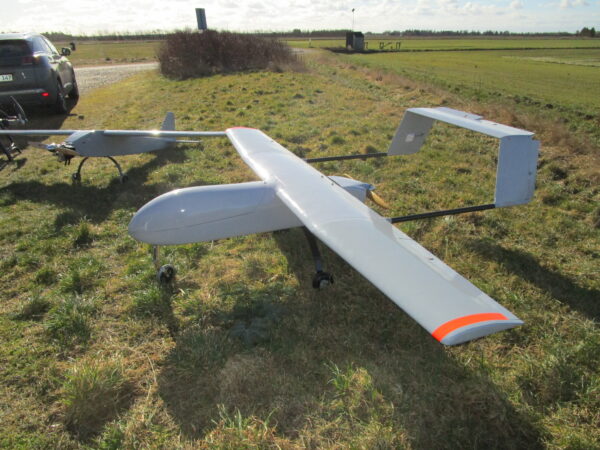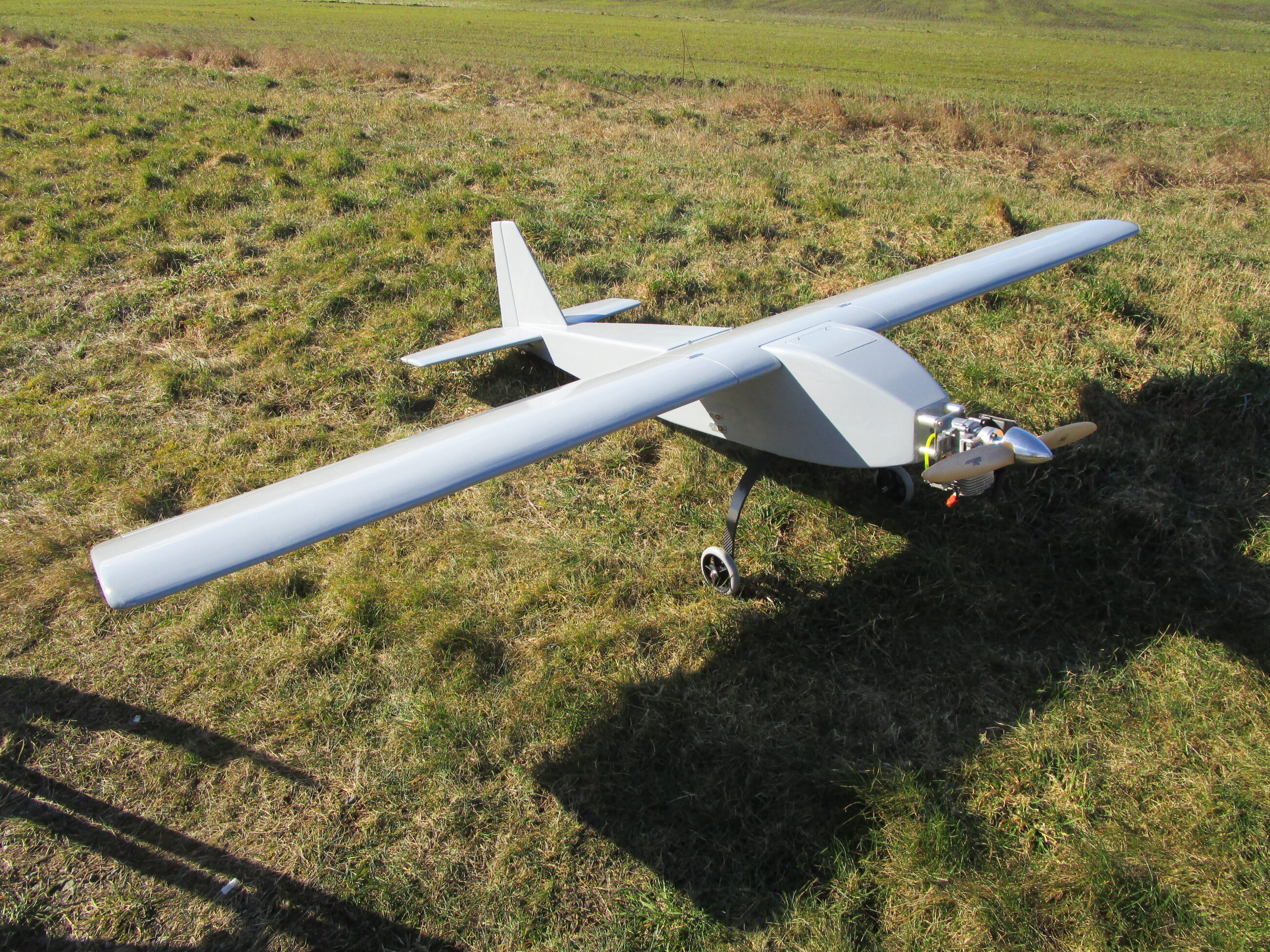The drones were technically and airworthiness RC approved to be RC Drones on saturday 4th of March. The approval and test flights were performed at Lindtorp Airfield at Jutland.
The weather was somewhat challenging as the wind were more than 14 knots with wind gusts up to 19 knots. On top of that, a quite cold temperature that produced a windchill factor that could be felt in the fingers when using the RC Control stick. However due to the size and weight of the drones, we decided to test fly both drones using the airfield taxiway as a runway as the crosswind on the main runway was too high.
The first drone tested was the special build drone for the IMAR. The Drone is now designated: Dines-005 as a RC Drone (VLOS). The drone will be renamed to: UAV-005-DTU when the Autopilot is installed, and the system has been test flown as BVLOS drone.
The pilot notes on the test flight:
The drone was refueled with 1,9 liter of gasoline and taxied to the take-off position. I only applied slightly more than ½ Throttle and after a short take-off roll, the drone got airborne (See the video of the test flight). The controls deflection was perfect, and the drone respond to flight control input was/is perfect. No Trim was needed on any of the tree axis. The drone was tested with both abrupt and soft maneuvers and thereafter taken to high altitude to check the stall characteristics which showed a very stable flight with no tendency of tip stall or roll, even with full elevator deflection. This is surely due to the wing washout we build into the wing construction. In the video you can see that we also tested full throttle flight, climb ability, slow flight, and tight turns. All vent well so the landing was performed on the taxiway.
The technical details of the Dines-005 Drone are as follows:
- Wingspan : 299,0 cm
- Fuselage Length: 214,5 cm from Spinner to Rudder.
- Engine: 62ccm Gasoline Piston Engine with Magneto Ignition system (Independent of supply of electrical power).
- Fuel Tank size: 1.9 Liter.
- Fuel type: 95 octane gasoline with oil mixture.
- Propeller: Diameter: 24-10 Inch (61 cm.) This is a large propeller for this engine, however purposely selected to ensure a low noise signature via low engine RPM.
- Engine Starting System: External Electrical starter. (No weight onboard).
- Flight Control system: Basic Primary Flight Controls with Aileron, Elevator and Rudder. Redundancy on Elevator and Aileron.
- Servos used: 2x Aileron, 2 x Elevator, 1 x Rudder, and 1 x Engine Throttle. Servo type: Futaba Digital High Quality with Ball Bearings and Metal Gears.
- Onboard electrical Power: 2 x NI-MH 5 cell (6 VDC). Auto monitored via Digital switch for redundancy power to Receiver.
- Receiver: Futaba Digital FASST 2,4 Ghz with Bi-directional Link, locked to transmitter via Channel Hopping and S-Bus capability. The Bi-Directional link enables ground monitoring of the Onboard Battery Voltages on the Receiver batteries during Flight. A Low Battery Voltage Warning System is fitted and active.
- The Drone is now approved for flight at a Maximum Take-Off Mass of 25,0 kg.
After this the second drone was prepared for test flight. This drone is one of our own drones that we have modified to become a back-up drone for the DroneSOM project. The initial drone’s name as RC (VLOS) drone is: Dines-004. The wingspan was reduced from 336 cm to 299,6 cm to get below the maximum 300 cm (Regulatory issue). Several other modifications were also performed prior to this test flight.
The pilot notes on the test flight:
The drone was refueled with 1,5 liter of gasoline fuel (Capacity is 3,06 liter). The engine was started, and some taxi checks was performed. Due to the northerly wind, we also made the take-off on the taxiway. The drone accelerated and got airborne after aprx. 25-30 meters take-off roll. The drone was also tested for stability, slow and high-speed flight and stall characteristics, flight control deflection and it also proved to be very stable and non-critical in all aspects. The dummy IMAR weight was set at 7,00 kg. With this weight and the 1,5 liters of fuel, we were precisely at 25,0 kg MTOM, this is slightly below the target of the 8,0 kg payload (IMAR installation) so this drone needs further modification to save more weight to be a full back-up drone.
The technical details of the Dines-004 drone are as follows:
- Wingspan: 299,6 cm.
- Length: Will be further modified.
- Engine: Same engine as on the above Dines-005 Drone.
- Propeller: Same Size as the above Dines -005 Drone, however a “Pusher CCW” Propeller.
- Engine Starting: Same as the above Dines-005 Drone.
- Fuel Tank Size: 3.06 liter.
- Flight Control System: Basic Primary Flight Control system with two Ailerons, two Elevators and two rudders, Nose Wheel Steering and Engine Throttle.
- Servos used: Futaba High Quality Digital, with Ball Bearing and Metal Gears. 2 x Aileron, 2 x Elevator, 2 x Rudder, 1 x Nosewheel Steering, and 1 x Throttle. This gives redundancy of the primary flight controls.
- Receiver system and batteries are the same as the above Dines-005 drone.
- The drone is now approved for flight at a maximum take-off mass of 25 kg.
Sunday was mainly used for testing the autopilot system. This was performed on a “Low Cost” electrical RC Plane, all to evaluate the autopilot capabilities and operational stability. The tests performed proved very well operational capability and we are continuing those tests to increase the Autopilot Telemetry distance.


